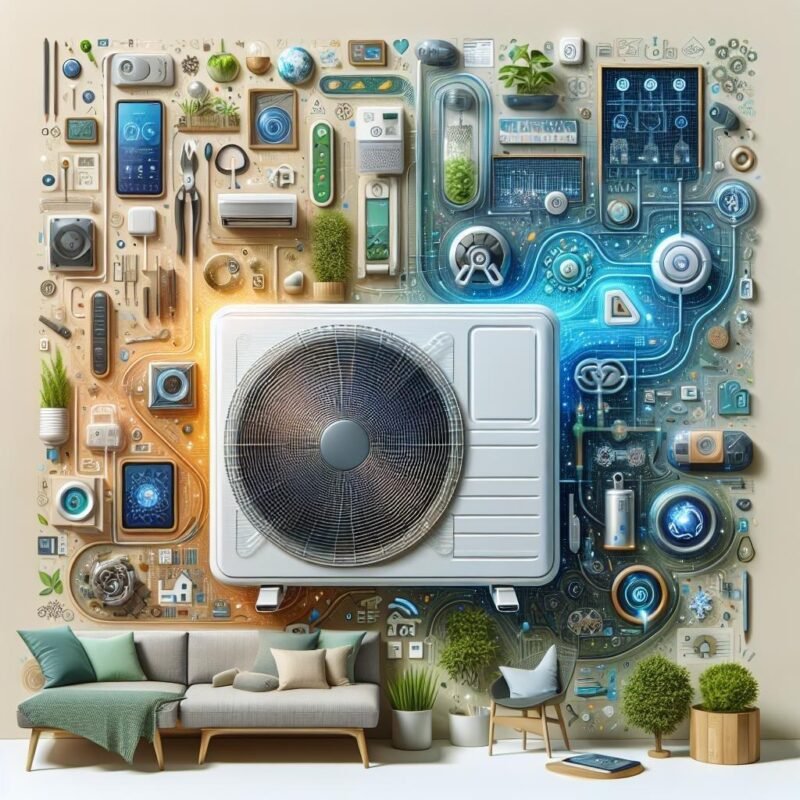Comparing Mini Split AC vs. Evaporative Coolers

As summer’s scorching embrace tightens its grip, homeowners find themselves at a crossroads in the quest for the perfect cooling solution.Picture this: you’re standing in front of two distinctly different cooling champions – the sleek, modern mini split AC system and the eco-friendly evaporative cooler, each promising to transform your sweaty sanctuary into a cool paradise. But which one should you crown as your home’s cooling hero? Let’s dive into the refreshing world of cooling technology and uncover the unique charms and challenges of these popular climate controllers.
Understanding the Cooling Battle: mini Splits and Evaporative Warriors Face Off
In the realm of modern cooling solutions, these two contenders bring thier unique arsenal to the temperature-taming arena. While mini-splits flex their muscles with precise temperature control and whisper-quiet operation, evaporative coolers champion the eco-friendly corner with their natural cooling approach. It’s like watching a sophisticated urbanite face off against a desert-wise warrior, each with their own set of tricks to keep you cool and cozy.
Let’s break down their superpowers:
- Mini splits deliver ninja-like precision cooling
- Evaporative coolers rock the natural cooling vibe
- Mini splits work anywhere, rain or shine
- evaporative coolers thrive in dry climates like a cactus
| Feature | Mini Split | Evaporative |
|---|---|---|
| Cooling Style | Tech Wizard | Nature’s Way |
| Best Climate | Worldwide | Dry Heat |
Energy Bills and Mother Earth: How these Cooling Champions Stack up
In the battle for eco-friendly cooling, both systems bring their A-game to the table. Mini split AC units have made extraordinary strides in energy efficiency, boasting SEER ratings that can slash electricity bills by up to 30% compared to conventional central air. Meanwhile, evaporative coolers are the natural champions, consuming a mere fraction of the power – typically using about the same electricity as a standard ceiling fan.
Let’s talk about carbon footprints and wallet impact. While mini splits rely on refrigerants that could potentially contribute to greenhouse emissions,modern units use eco-friendlier options like R-410A. Swamp coolers win the sustainability race hands down,using just water and air to work their magic. Here’s what the monthly operating costs typically look like:
| Cooling System | Monthly Cost (1,000 sq ft) | Environmental Impact |
|---|---|---|
| Mini Split AC | $30-45 | Medium |
| Evaporative Cooler | $5-15 | Low |
Comfort Zones and Climate Match: Finding Your Perfect Cooling Companion
Ever wondered why some homes feel like a refreshing oasis while others struggle to beat the heat? The secret lies in understanding your home’s unique climate personality. Different cooling solutions shine in distinct environments – think of mini-split ACs as the sophisticated urbanites, thriving in humid cityscapes, while evaporative coolers are the desert-dwelling free spirits, performing their best in dry, arid conditions.
Let’s match your space with its ideal cooling companion:
- Hot and humid regions: Mini-splits reign supreme
- Dry, desert areas: Evaporative coolers work magic
- Mixed climates: Consider seasonal switching
- Indoor comfort preferences: Temperature precision vs. natural cooling
| Climate Type | Best Choice | Comfort Level |
|---|---|---|
| Coastal areas | Mini Split AC | High |
| Desert Regions | Evaporative Cooler | Optimal |
Making the Smart Choice: Real World Performance and Bang for Your Buck
Let’s dive into what matters most – actual cooling capabilities and cost efficiency. A 24,000 BTU mini-split system can effectively cool up to 1,500 square feet, handling even the most sweltering summer days with ease. While the initial investment of $1,500-$4,000 might seem steep, these systems boast impressive SEER ratings of 16-30, translating to lower monthly bills. Evaporative coolers, typically priced between $300-$1,000, shine in dry climates where they can drop temperatures by 15-40 degrees Fahrenheit while using up to 75% less energy than traditional AC units.
Consider these practical factors before making your decision:
- Mini splits maintain consistent temperatures irrespective of outdoor humidity
- Evaporative coolers require regular maintenance and water refills
- Mini splits offer both heating and cooling capabilities
- Swamp coolers work best when windows are slightly open
| Feature | Mini Split | Evaporative |
|---|---|---|
| Monthly Cost | $30-60 | $10-25 |
| Lifespan | 15-20 years | 8-12 years |
Q&A
Q&A: Comparing Mini Split AC vs.Evaporative Coolers
Q1: what is a mini-split AC system, and how does it work?
A1: Great question! A mini-split AC is a type of air conditioning system that consists of an outdoor unit and one or more indoor units.These systems use refrigerant to absorb heat from inside your home and release it outside, keeping your living space cool and comfy.Picture it as a little cooling wizard that quietly works its magic without the need for ductwork!
Q2: What about evaporative coolers? What makes them special?
A2: Ah, the evaporative cooler! Also known as swamp coolers, these refreshing devices cool the air through the process of evaporation. They work by drawing warm air through water-saturated pads, resulting in a delightful breeze that lowers the temperature. Imagine standing near a cool river on a hot day— that’s the vibe they bring! But remember, they work best in dry climates where humidity isn’t too high.
Q3: which one is more energy efficient?
A3: If energy efficiency had a friendly competition, evaporative coolers would often take the crown, especially in arid areas! They use significantly less electricity because they primarily rely on water evaporation rather than refrigerants. Conversely,mini-splits are quite efficient for cooling and heating but generally consume more power. So, if you’re looking to save on those bills, evaporative coolers might give you a little smile!
Q4: How do climate and location factor into the decision?
A4: Climate is key! In dry and hot regions, evaporative coolers can be your new best friend, providing a cost-effective solution with refreshing air. On the flip side, mini-split AC systems shine in humid climates where evaporative coolers may struggle to cool effectively. Think of it this way: if you’re by the beach, go for a mini-split. In the desert,an evaporative cooler is your pal!
Q5: What about installation and maintenance—what’s involved?
A5: Mini-split AC systems require professional installation,which can be a bit of an investment upfront. However, once installed, they last a long time and typically require minimal maintenance. Evaporative coolers are generally simpler to install and can often be set up by handy homeowners. They do need regular maintenance,though,like cleaning or replacing pads and ensuring water levels are just right. So, if you’re a DIY enthusiast, that might tickle your fancy!
Q6: Which option is better for allergy sufferers?
A6: If allergies are your nemesis, mini-split ACs might have the upper hand. They can be equipped with advanced filters that help trap dust,pollen,and other pesky allergens. Evaporative coolers, while offering refreshing air, can sometimes pull in dust from outside sence they don’t have the same robust filtration systems. So, allergy warriors may want to lean toward mini-splits for relief!
Q7: which one do you recommend?
A7: It all comes down to your unique situation! If you crave efficient cooling without spending a fortune on electricity in a dry climate, an evaporative cooler could be your summer soulmate. But if you live in a humid area and desire full control over your home’s temperature year-round, a mini-split AC system is your go-to choice. Whatever you choose, both will bring a breeze of freshness to your space. Happy cooling!
The Way Forward
In the grand battle of cool versus cooler, both mini split ACs and evaporative coolers bring unique strengths to the table, ensuring your summer stays as refreshing as a gentle breeze on a sweltering day. Whether you prioritize efficiency, versatility, or eco-friendliness, the choice ultimately depends on your specific needs and environment.
As you embark on your quest for the perfect cooling solution, remember that it’s not just about the temperature—it’s about creating a comfortable oasis where memories are made and laughter echoes. So, take a moment to weigh the pros and cons, envision your space, and choose the option that sings to your heart (and wallet).
As you embrace the warmth of summer, may the coolness of your chosen solution wrap around you like a gentle hug, ensuring every gathering, movie marathon, or afternoon nap is blissfully enjoyable. Here’s to beating the heat with style and comfort—stay cool, friends!






















